This Sunday, we have our first real challenge for Barcelona in the LaLiga Feminina, having dominated last season’s campaign, finishing with just one loss to Madrid CFF, winning the league title by 10 points over Real Madrid.
Barca then went on to win the UEFA Champions League, beating Wolfsburg 3-2 in the final. Then, many of their players went on to win the Women’s World Cup with Spain, with Keira Walsh and Lucy Bronze being losing finalists in that game.
Contrary to Barca, Atlético Madrid had a disappointing 2022/23 campaign, missing out on Champions League qualification. However, they have started unbeaten this season, sitting in third position.
As you can see, Barcelona are currently the standard when it comes to women’s club football. In this tactical analysis piece, we will look at both teams’ respective tactics in order to highlight some ways by which Atlético Madrid may be able to pose some problems for Barcelona in this tactical analysis in the form of a tactical preview of Sunday’s clash.
Team News
We’ll start off with the home team here. Goalkeeper and captain Lola Gallardo would be expected to start between the sticks. However, Atleti’s backline has chopped and changed a fair amount at the start of this season, with Merel Van Dongen, Xènia Pérez and Carmen Menayo all starting as CBs for Atleti in a variety of combinations as they look to find their preferred combination.
Additionally, Atleti’s fullbacks have varied somewhat, with new signing RB Ana-Maria Crnogorčević starting one of the games in the three-day turnaround game against Villarreal. However, the most common combination has been Andrea Medina at LB and Ainhoa Moraza at RB.
In midfield, Atleti have also changed somewhat throughout the season, with Sonia Majarin starting every game as a deeper midfielder and Leicy Santos starting as the 10 playing behind the striker. However, it’s that third midfielder that has changed a fair amount, with Estefania Banini starting there in two of the four games but also new signing Vilde Bøe Risa from Manchester United and Gabriela Garcia starting in the second deeper midfield role.
Then comes Atleti’s front line. The mainstay has been new signing Sheila Guijarro, who has begun every game as the sole striker. However, Atleti have several options in the wide players and on the left, they have gone with either Rasheedat Ajibade or Estefania Banini and on the right, they have used Marta Cardona, Eva Navarro and Ana-Maria Crnogorčević.
Then comes the reigning European champions. In goal, they have split game time between Catalina Coll and Sandra Paños. The defensive line has varied massively throughout the season to date, with nobody having started every game; however, Ona Battle at LB and Lucy Bronze at RB has been a recurring theme of their lineup and has a big part to do with the success they have been able to have.
The CBs, however, have changed somewhat with Mapi León, Irene Paredes, Marta Torrejon, and Jana Fernández earning starts; however, I would suggest that León and Paredes is their best partnership and has proved most effective this season and last season as well.
Then comes the midfield, where Barca have an embarrassment of riches, having tended to favour Ingrid Engen at the base of their midfield three and then predominantly Patricia Guijarro playing on the left of the midfield. While on the right, it has tended to be Aitani Bonmatí. With England international Keira Walsh only just returning from injury so has had limited game time coming into this game.
In the forward line, they have generally deployed Caroline Graham Hansen on the right wing, Clàudia Pina on the left and captain Alexia Putellas through the middle.
Barcelona’s Wide Overloads
Barcelona this season have dominated possession, averaging 68.25% per game. On average, Atlético Madrid has 53.5% possession per game this season; however, in their game against Levante, whose style is the closest to Barcelona’s in terms of quality of squad and style of play, Levante dominated the ball 64-36. As such, this will be the case again this season. Now, one of the main reasons that Barcelona can dominate the ball is through these wide overloads.
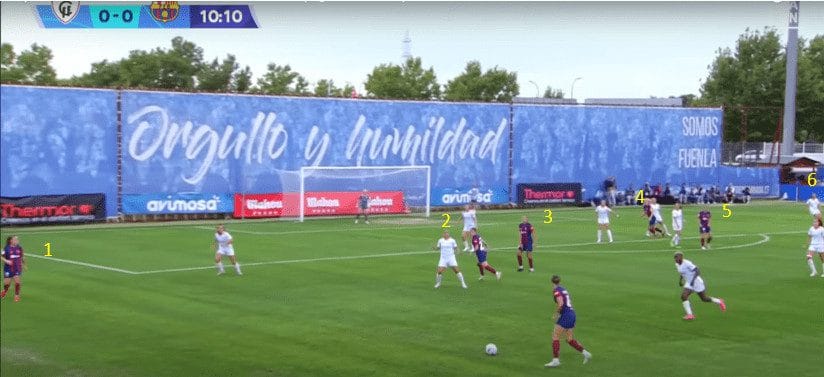
Above is an excellent example of the way that Barcelona look to stretch the field horizontally. They are playing with six players across the opposition defensive line. In the above example, you have Mapi León on the ball, who has pushed forwards on the ball into midfield. Then, from left to right, you have Clàudia Pina, Ona Battle, Patricia Guijarro, Alexia Putellas, Aitani Bonmatí and Caroline Graham Hansen.
Now, this is dangerous for several reasons. First, it should always give them a forward pass, often to a wide player, as opponents rarely match Barca with six defenders, so it would force at least one midfielder to drop in and help the defensive line. Second, Barcelona are so efficient in their combination play that they can receive the ball with their back to goal, link each other, and then play some short, sharp combinations with movement that looks like clockwork to cause opponents nightmares.
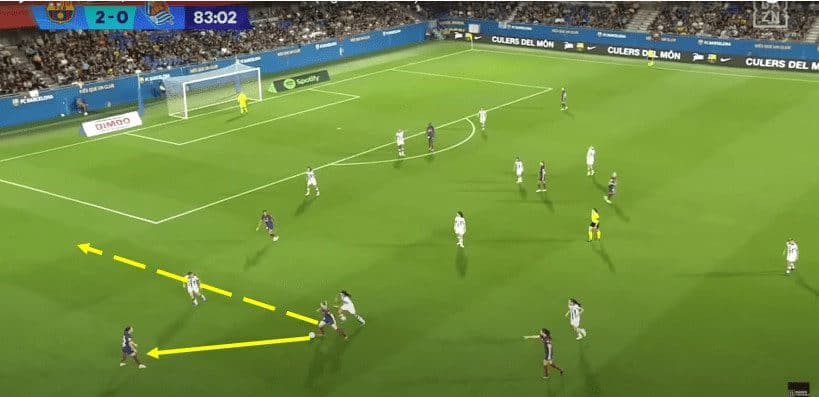
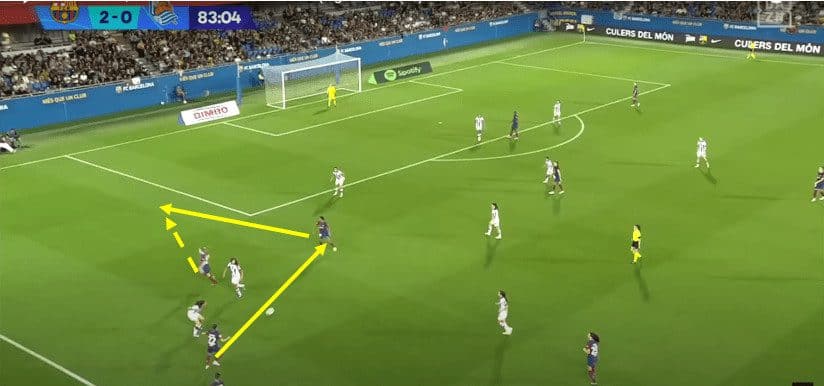
Above is an example of this excellent movement within the wide channel, with Keira Walsh passing the ball out wide to Battle. Walsh then extends her run and receives the ball back from Esmee Brugts before Walsh plays it across the box to Graham Hansen, who taps it in on the back post. This is a fantastic example as it shows the amount of off-the-ball movement going on when Barcelona have the ball with players making third-player runs and just expecting to be involved again.
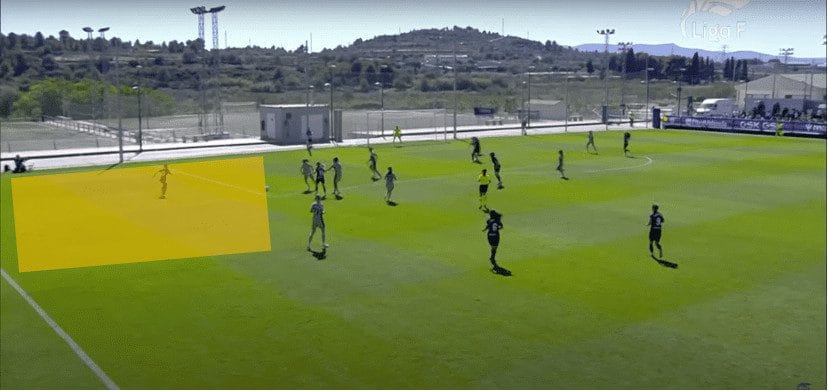
Above is an example of what would worry me with how Levante got out wide and around the Atleti defence, particularly as they haven’t pushed nearly as many players as Barca. In this game, Atleti struggled, allowing Levante 6 shots in the box and 12 in total; where you’d have to imagine if Barca are afforded that, they will punish Atleti—particularly given how dangerous Barca have been from crosses so far this season, having already scored eight goals in the opening four games of the season directly from crosses.
Can Atleti test Barca in behind
With Barcelona looking to dominate the ball and push bodies forward, this can leave them thin for numbers at the back. Here, I will look at several ways that Atleti may be able to target Barcelona in this area. Below is an example of where the spacings could be on either side of the CBs with both fullbacks pushing forward, almost leaving you with only three players at the back in transition, two CBs and CDM.
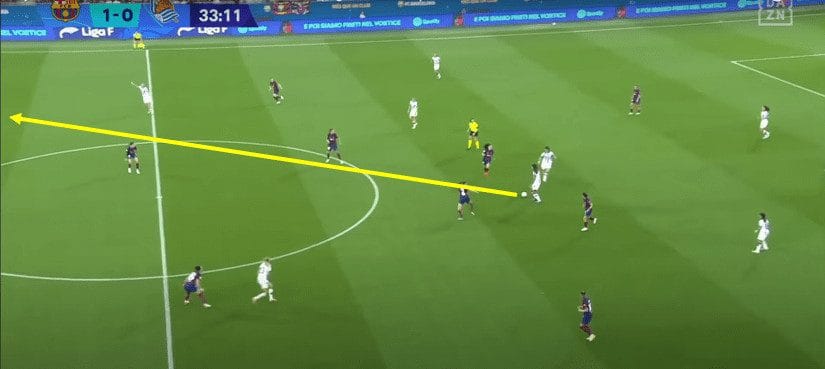
Above is an example of how Sociedad were able to launch an attack by targeting the space behind the LB with a through ball to the attacker. However, the CBs do defend well, particularly LCB Mapi León, who forces the opponent wide, and in the end, she has to take a shot from the right side of the box with a defender beside her, making it an awkward shot to have to make.
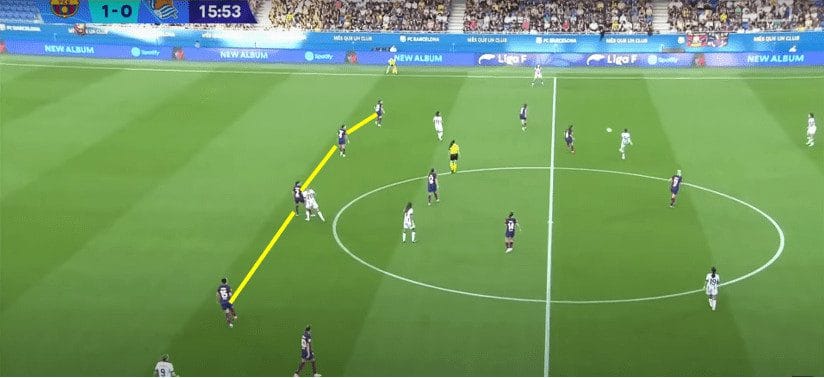
Above is another example of that high defensive line. This time, you can see how compact the midfield-defensive line is. This will likely limit somebody like Leicy Santos’ space, which space where she wants it in and around the box. However, it does allow them space to get behind the opposition if they can execute.
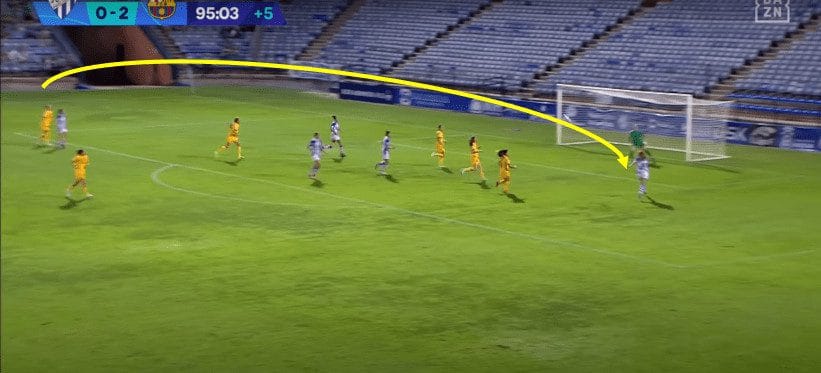
Above is an example of the only goal that Barcelona have conceded this season in the last kick of the game against Huelva. Now, although you could argue that the game was done by this point, I think it’s interesting to note that the goal was scored from a deep cross over the top of the defence for the player arriving at the back post to finish off as it’s an example of how this Barca team can be targeted in behind using good timing as accuracy.
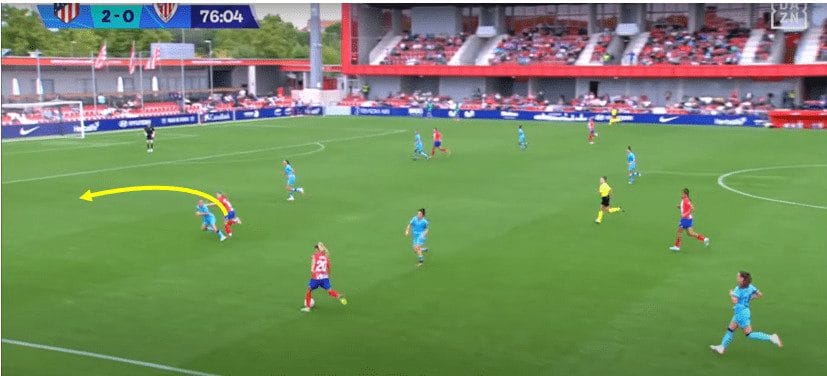
Now, all that is well and good, but it’s all irrelevant if Atleti have no way to target this. I think they may, however, above is an example of Eva Navarro for the third goal against Athletic Bilbao where she makes this outside-in arcing run behind the defensive line where she can play the ball across the box and Sheila Guijarro can finish it off.
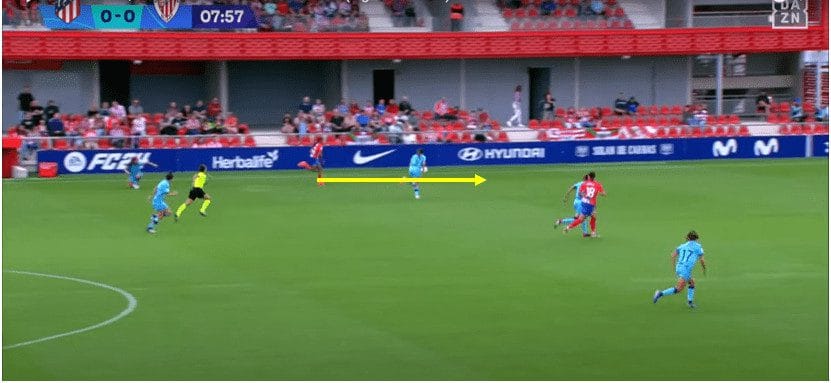
Another player who can take advantage of these spaces in the wide channels during transition is Rasheedat Ajibade, who has rapid speed and good strength, which makes a real problem when trying to get forward in transition where the spaces open up.
Set Pieces
Now, another particularly interesting area that Atlético Madrid and Barcelona may have some joy in is set pieces. With Atlético Madrid, they have Leicy Santos, who has excellent technical quality and takes corners, particularly from both sides.
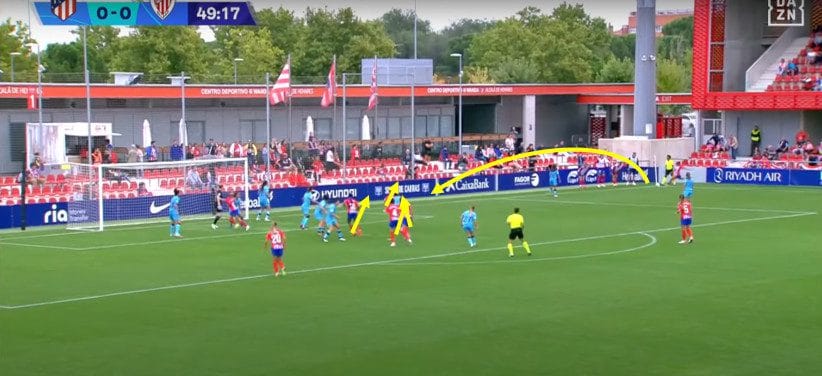
In the above example, Santos plays an out-swinging ball into the box. There’s one Atleti player who starts centrally around the box. Then, you’re going to have four Atleti players make moves towards the front post, where Guijarro can time it excellently and head home from close range.

Alternatively, the above is an example of a goal scored against Villareal, but this time, Sonia Majarin plays an inswinging ball into the box with her left foot. The principles of this goal are very similar in that the Atleti players end out around the front post where the ball is directed. However, the main difference in this above example is nobody gets on the end of the header, Merel van Dongen peels around the back, and the ball ricochets off her into the back of the net.
On the opposite side, Barcelona has scored several goals from corners and looked dangerous throughout. They are more creative with their set plays, however, mixing up routines and have the ability to go both short and play balls directly into the box.
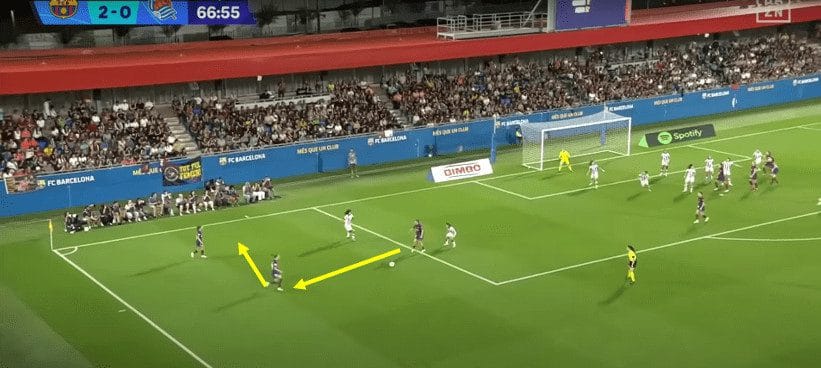
Above is one of these examples of short corner routines where they take it quickly, and Caldenty comes out into the wide channel to create a 3v2, which they are then able to execute effectively and the ball is played across the box to the back post where Bronze gets a header on target.
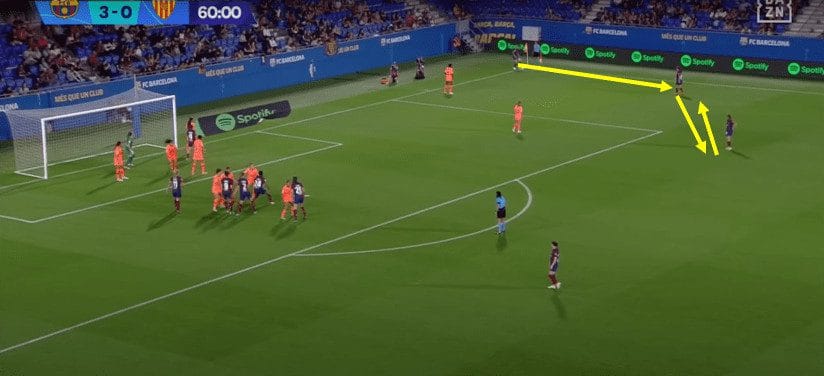
Above is another example of a short corner routine where the ball is played short to Mapi León, who then plays a one-two with Bonmatí before León crosses the ball in with her left foot. This ball goes untouched and into the back of the net. This is an excellent example of how Barca may look to change the angle and use different footed players to create problems for Atleti to solve.
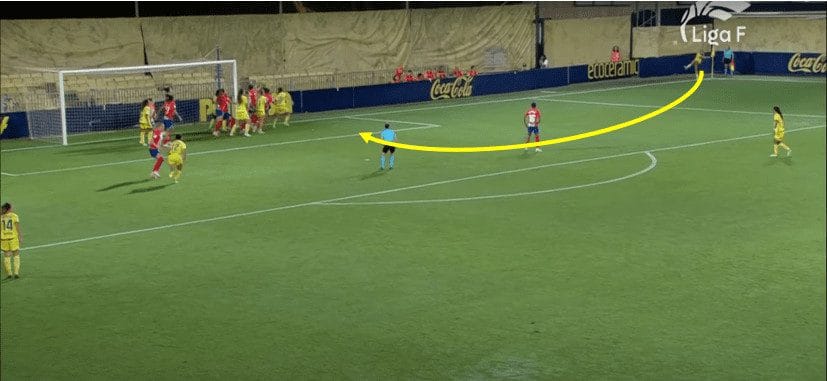
I think it’s also important to note this example of Atleti struggling to deal with a congested front post corner routine with an inswinging delivery. With the GK, Lola Gallardo never looking likely to command her space and deal with this ball confidently.
Conclusions
Barcelona has been the standard for women’s football for the last few years, and that remains the case to date. Many of the players from this year’s World Cup final are playing for this Barcelona side. The number of ways they can beat you with their depth is so substantial they have a plethora of options they can go to if needed.
That being said, if Atleti can hold on defensively, there are ways in which Barca could be potentially targeted, and they do have real quality themselves, not least with Leicy Santos. It may be a bridge too far, and Barcelona should run out winners on Sunday afternoon.






Comments